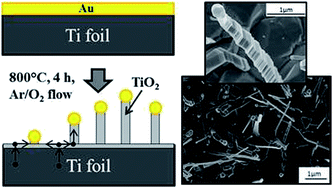Single-crystal TiO2 nanowires by seed assisted thermal oxidation of Ti foil: synthesis and photocatalytic properties†
Abstract
TiO2 nanowires (NWs) can improve the advantageous photocatalytic properties of TiO2 by increasing the active surface area. Here we investigate the synthesis of TiO2 NWs by thermal oxidation, studying the role of temperature, annealing time, and gas flow rates. The optimal thermal growth conditions were found to be 800 °C for 4 h in a mixed gas flow of Ar and O2. Morphological and structural characterizations, carried out by scanning and transmission electron microscopy, and X-ray diffraction, indicated a TiO2 rutile monocrystalline structure of the nanowires. An in situ thermal growth analysis was performed by means of an environmental electron microscope, providing additional insights into the TiO2 NWs growth dynamics. The photocatalytic properties were studied by using the degradation rate of methylene blue under UV light. TiO2 NWs revealed a 70% improvement of the degradation rate compared to a reference TiO2 bulk sample. Moreover, NWs were additionally annealed in forming gas (5% H2 in N2) in order to promote the formation of oxygen vacancies and an increase of the carrier density. Indeed, the photocatalytic activity of the NWs treated in forming gas was 3 times higher than that of the reference TiO2 bulk sample. The photonic efficiency and the quantum efficiency, also showed an increase versus bulk TiO2 of about 20% in the presence of NWs, and of about 100% with the forming gas annealing. Moreover, this increase in the photocatalytic activity after the forming gas annealing also correlates with the disappearance of a deep level recombination center as observed by deep level transient spectroscopy.


 Please wait while we load your content...
Please wait while we load your content...